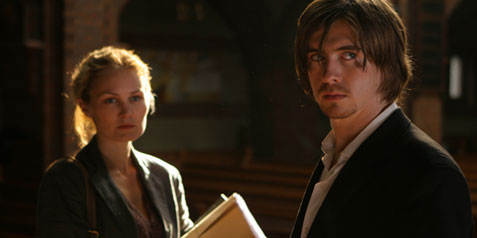Film Friday
Occasionally a film comes along that approaches the depth that I take for granted in literature. I’ve only watched the 2008 Norwegian film Troubled Water once (with my film group), but on first encounter it appears to be such a film. I reveal spoilers in the following review to do credit to the film’s exploration of the labyrinths of the human mind.
A teenager (Tomas) who has been sentenced to a long prison term for kidnapping and murdering a child is, after many years, released from prison and finds a job as a church organist. He believes that he did not kill the child—he ran off with the stroller with the child in it, probably looking for money for drugs, and the child ran away, hit his head, and drowned in a stream. Tomas begins a relationship with the church’s priest (she doesn’t know his past) and bonds with her son. The mother of the dead child discovers that he is working in the church and reverses the roles, running off with the child that he now cares for. In the end, they come perilously close to reenacting her child’s death with the living child. Out of that confrontation, Tomas realizes that he could have saved the child—that he has been repressing certain details—and the mother learns how the event might have spiraled out of Tomas’s control, making him something less than a killer.
The film is powerful in the way that a Jean Renoir film is powerful. I’m thinking of Rules of the Game where a character says, “The problem is, everyone has his reasons.” Everyone in Troubled Water is sympathetic, everyone has his or her reasons, and when the force of the melodrama pits characters we care about against each other, the spectator is torn as well. Through the use of two points of view—a number of the scenes we see twice—the film doesn’t let us dismiss anyone as one-dimensional.
In our society where many seem intent on judging harshly—whether it be criminals, undocumented workers, or others—it was healing to see a film (and to see Norwegian society) where nuance is acknowledged, even in the most horrific of crimes. When the mother berates the church warden for taking in Tomas, a man that we had previously dismissed as rigid reveals a different side when he humanely asks, “Where should someone like that go but to a church?”
In another scene, where the mother and her husband are out dining with her husband’s new boss, the man’s wife unexpectedly opens up to her about her own loss, a drug addicted son who is virtually dead to her, even though she sees him from time to time. In that moment the mother learns what I learned following the death of my own son: one’s tragedy can be an opening for others to express grief. In other words, even the most heartrending of losses has gifts to offer.
The film gets its name not only from the turbulent waters that drown the boy but from a remarkable organ rendition of Simon and Garfunkel’s “Bridge over Troubled Water” that Tomas plays for children visiting the church. It is during that visit that the mother recognizes him, and even though her recognition leads to their confrontation, the confrontation itself is necessary. He must confront the lie he has been living if he is to step fully into a new relationship. She, on the other hand, needs closure if she is to reconcile with her teenage daughter, who feels the weight of the dead child in their family.
So the film is a bridge over troubled water. But not in any predictable way, not in a way that doles out cheap grace and forgiveness, not in a way that neatly ties up loose ends. The future is uncertain and difficult work must be undertaken. But we the viewers emerge with a renewed appreciation for the complexity of human beings.


